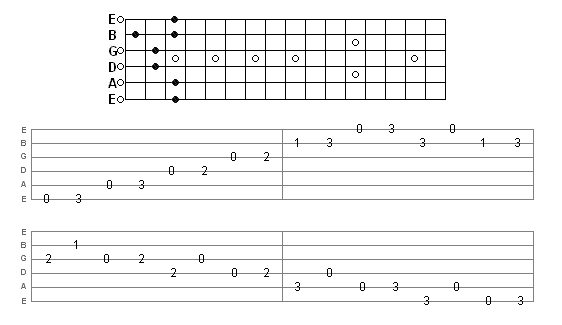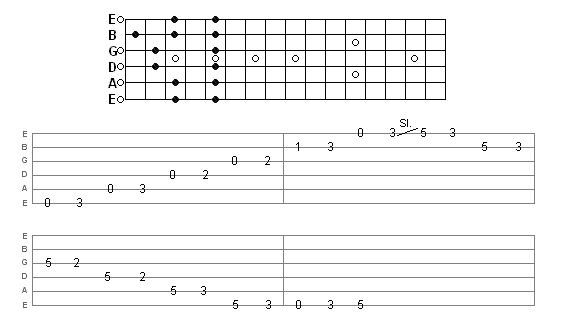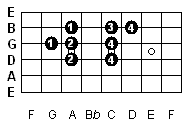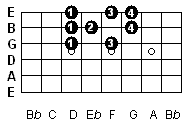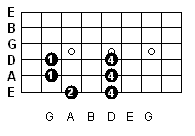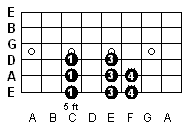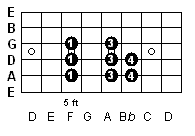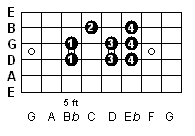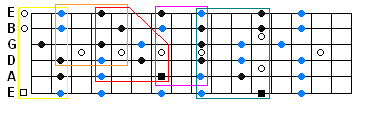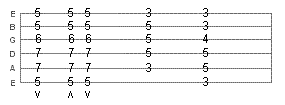Test Your Skills – Perfecting Your Technique (Part 2)
While teaching the pentatonic scales, it seems as though it leaves my students wondering “what next?” Well, here’s a few skill builders to show you why and how the pentatonic boxes connect. We’ll be in the key of C. To start, let’s take a look at the pentatonic box 3…or the E Phrygian scale.
Below is a simple skill builder starting at the top of the neck. Most instructors should tell you not to focus on playing scales from bottom to top in formation. While this one goes from bottom to top and back down again, it’s the way it comes back down that’s unique. Notice the pattern is in-line while going up the scale, but it’s altered coming down. This trains your mind to think…”outside ‘the box'”…excuse the pun.
One of the most difficult concepts to teach, as well as understand, is how the pentatonic boxes fit together. This next skill builder shows how to use a slide at the end to bring you from the E Phrygian scale to the G Mixolydian scale on the way back down.
Let’s take this a step further. First, we won’t be going up, we’ll be coming down. Second, we’ll be using the E Phrygian scale, the G Mixolydian scale, and the A Aeolian scale…or the minor pentatonic scale.
If you look at the fretboard diagram, you can see how we added the bottom part of each pentatonic to the previous one. This is because the bottom of each pentatonic is the top of the one we’re adding. In the example above, you can see where we transitioned between the scales by using slides. While this isn’t the perfect demonstration, it does show how you can merge three pentatonic scales together. Knowing your scale patterns and how they all fit together will help you play up and down the neck of the guitar with little effort.
R. I. P. Sammy Johns
January 4, 2013 was a sad day for music. Sammy Johns, singer and songwriter, died at the age of 66.
Johns was known for the classic hit Chevy Van. At age 9, he got his first guitar from his dad. By the time he was in his teens, he started his own band called The Devilles.
Artists that Johns wrote for, or who covered his songs, include John Conlee, Waylon Jennings, Sammy Kershaw, and Conway Twitty.
Two Years and Nearly 3,000 Visits
Well, as of yesterday, it’s been two years since this blog was started…and what a great run we’ve had. In those two years, there have been nearly 3,000 visits. While that’s nothing like the 2.7 million views that Psy got for Gangham Style, for this type of blog in it’s beginnings, it’s a good start…and things can only get better.
As we draw closer to 3,000 visits, I want to reflect on last year and let you know that there will be even more to look forward to. Last year, 600 people reached the top of Mt. Everest. This blog got about 2,200. Since the beginning of the year, there has been 147 visit. That’s roughly 21 visits a day. Not bad. And with the total views since this blog was started being 2,869, that means that last year was better than the first year and this year is looking even better.
There were 15 posts with 36 images uploaded. The plan is to add more posts with even more information and more images. The best part for the viewers…it’s all free for you to view. I’m sure, down the road, there may be a need to look towards advertising, or adding a link for donations may happen because, as fast as this blog is growing, it may reach it’s limits. Until then, enjoy the benefits of free lessons without being misleading by having to buy a DVD.
The busiest day of the year was October 29th with 40 views. Since then, there have been several days in the 30s. This type of traffic is good to see because it means that people are learning about this blog and finding out that there’s real tabs and real lessons for guitar, where some sites briefly explain a concept and leave you hanging, or create a tab that sounds nothing like the actual song. All images, whether tab or instructional, are intended to give the viewer a better understanding of what their learning.
So, what can you look forward to? Well, I know, through viewing the traffic reports that the Mustang Sally solo is one of the most popular visits. I do have to apologize, but that solo will be revamped because, as my goal is to give you real tabs, I looked to an online tab to learn Mustang Sally and never found one with a solo or any fill-ins. The tab I found was a fairly fast, rock-style version of the song and I created the solo upon that. I do have to thank Steve who commented on that post that it was written in 12 bar blues when the actual song is in 24 bar blues. His disappointment led to my disappointment, and I can’t have that. Also, I’ve posted tabs to other songs, but have not added the solos for those either. Those will also be done this year so you will have complete tabs, with their explanations, to view and learn from.
Other than that, thank you to everyone who has given this blog such a wonderful year, and thank you to all the future viewers. I look forward to giving you the lessons you’ve been looking for without the need to empty your pocket book.
Know Your Scales – Revisited
Here it is…the first lesson of the new year!!
Recently, one I was teaching one of my students their scales. This student had taken lessons from a different instructor, but was feeling like something was missing. I was teaching the major scale and how, if you remove the 4th and 7th notes, it becomes the beginning of the major pentatonic scale. He mentioned that it looks different than the major pentatonic that he was taught. That’s because the previous instructor, who had a degree in music and played in three different bands, had taught him the wrong thing.
Below are two versions of the major scale. Notice the numbers for the fingers to use, and that the patters are the same, just on different strings.
These next two images are of the same scale pattern, but, because of the orientation of the B string, you have to shift the fingering just a bit.
My student was amazed that you could use the same position across the neck of the guitar. He was only taught how to start on the E or the A string. If you truly want to learn to play guitar, you have to know where the notes are on the fretboard and you have to know your scales. In the image below, I showed him how removing the 4th and 7th notes produces the beginning of the major pentatonic. Look at this, then scroll up and look at the G scale above. See how it works?
Then, I explained to my student that what he was taught was the minor pentatonic. To start, I first showed him the above examples, then showed him how the minor scales look. Below are the first two minor scales. Again, same pattern, just different strings. Also note that the above patterns started on the 3rd fret, where the ones below start on the 5th. All of the patterns I’m showing you can be played up and down the neck of the guitar, but, for learning purposes, I chose to start them like I did.
As with the major scales, the minor scales also have to be adjusted when playing over the B string.
Here is where I showed him that he was truly learning the minor pentatonic scale. Instead of removing the 4th and 7th notes, we will be removing the 2nd and the 6th notes.
My student was completely surprised, but later told me that it makes perfect sense when you remove the notes to get the pentatonic.
My advice…practice these scales up and down the neck of the guitar. Not only will you be able to play them better when you do, but your soloing will improve as well as you’ll have a much better idea of where each scale can be played.
Sunshine of Your Love (explained)
If you know anything about Eric Clapton, besides that he’s one of the greatest musicians of all time, you know he was also in several other bands that he is well known for such as The Yardbirds, John Mayall & The Bluesbreakers, and Derek and the Dominos. Before he was in Derek and the Dominos, he was also in the band Cream. One of his legendary hits was Sunshine of Your Love.
For those of you who know the song, many have tried to cover it, such as Jimi Hendrix, Blood Sweat & Tears, Living Colour, and Ozzy Osbourne…each with their own style. Staying true to the original recording, this tab is going to go beyond what other tabs out there have done.
Above is the intro to the song. Played in the key of A, many tabs on the internet have kept true to how this is played with one exception…if you notice when I bend the F on the 10th fret, I add a tiny bit of vibrato. If you listen closely to the original, you can hear a slight hint to this, but others who have covered it have made that vibrato more pronounced; which I feel adds to the song. This part is played twice before going into the main riff.
Where other tabs have gone wrong is the main riff. They keep showing the intro as if that’s all there is to the song. Once again, if you listen closely, you can hear the C and D bar chords as I have them tabbed here. This gives the feeling of two guitar parts with a single, richer sound like it is in the recording. This part is played four times before the next part, then twice after the next part.
Here again, I used the F and G bar chords for a richer sound. The rest of this riff was moved up one string, but is the same pattern. This part is played twice within each verse.
The part above is the bridge. This is played three times. Notice the strumming directions under the A bar chord at the beginning. Not only does this save you energy to strum this way, but it also adds to the sound that you can hear in the actual recording.
Above is the last part of the bridge. That’s the main part of the song. I’m still working out the solo, so keep checking back, and have fun with this one like I have. When you’re ready, try playing against the actual song.
